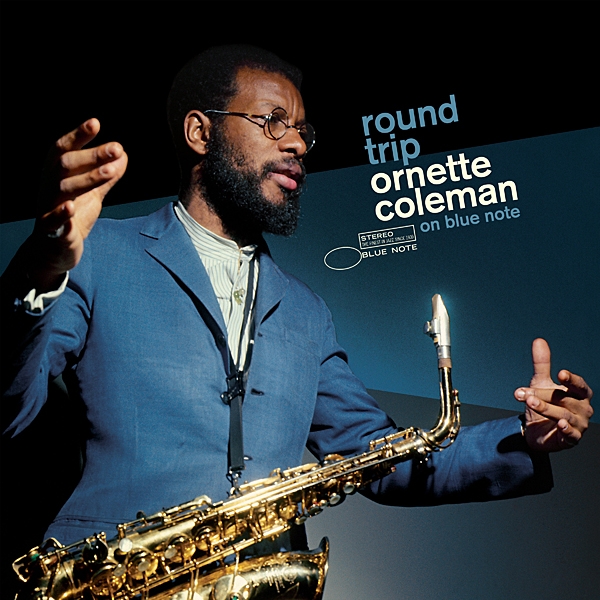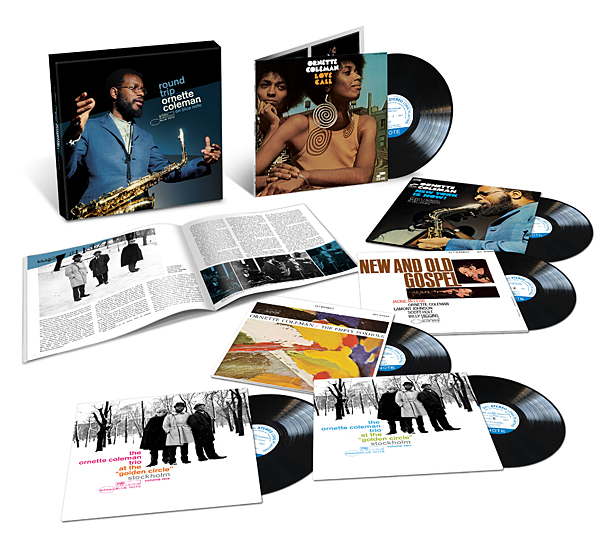| Columns Retired Columns & Blogs |
An excellent over-view as always, FK.
Big Ornette fan here.

Ornette's classic LPs are the six he made for Atlantic Records from 1959–61, especially The Shape of Jazz to Come, which Rhino and ORG have reissued in fine pressings. After taking a five-year break from record labels, Ornette signed with Blue Note (which was going through an experimental phase) and made five albums as a leader and one rare sideman session with fellow alto saxophonist Jackie McLean. These are the six LPs in the Tone Poet boxed set.
Ornette had disbanded his classic quartet by this time and recruited a rotating roster of players for these sessions. The first two, At the "Golden Circle" Stockholm (Vol.1 and Vol.2), are live albums recorded in Stockholm in 1965 with his old friend Charles Moffett on drums and David Izenzon on bass. Moffett plays much in the free style of Billy Higgins, but Izenzon weaves unfamiliar tensions within the rhythms and often plays arco in sync with (or against) Ornette's tone. And the tone is gorgeous.
On those Atlantic records, Ornette wailed on his horn and bent notes like a human voice. For some listeners, this took some getting used to. But between the Atlantic albums and the Golden Circle, his tone, still wailing, grew warmer. Or maybe this was the difference between Atlantic and Blue Note engineers. His compositions took on greater complexity, his melodies—and Ornette's music was above all melodic, though the lines didn't follow standard patterns or chord changes—unfolded along more extensive themes.

In 1966, he set up in Rudy Van Gelder's studio for The Empty Foxhole with Charlie Haden, his bassist from the Atlantic years, and Denardo Coleman, his 10-year-old son, on drums. Though the latter was a controversial choice, Denardo is quite good, following his dad's paces with pulse rhythms. Then again, would the album have been better with Moffett, Higgins, or Ed Blackwell? Probably. Haden is in fine form, though, and Ornette is lilting, intense, or both—except (here come the caveats) on half of the six tracks, where he either blows a trumpet or bows a violin. Some disagree, but I find him flat and warbly on trumpet, wincingly scratchy on violin. (He switched instruments on just one track of each Golden Circle album.) Otherwise, this is a terrific album.
In 1968, Coleman went into A&R Studios, with Dave Sanders as engineer, and made New York Is Now with an old friend from his Fort Worth days, tenor saxophonist Dewey Redman, and two sidemen from John Coltrane's classic quartet (which had disbanded a few years earlier): bassist Jimmy Garrison and drummer Elvin Jones. Some critics complained that Garrison and Jones seem to be playing on a different album, but I disagree. There's tension between the two horns and the Coltrane veterans, but it's a riveting tension. Jones is a propulsive force, pushing the tempo in a way that none of Ornette's other drummers ever did, and Ornette steps up his pace to match. The first track, "The Garden of Souls," starts with Ornette and Redman blowing the haunting, mystical theme, Garrison bowing the bass in something perched unsettlingly between unison and harmony, while Jones swirls on the trap set. It's magical, and the rest of the album sustains that sense. This was the only time Ornette recorded with this group, which is too bad.
Love Call was recorded at the same two sessions as New York Is Now, but it came out three years later. I wonder if its tracks were originally rejects from the earlier album. It's pretty good, but it's the lesser of the two works.
Ornette's rare sideman session with Jackie McLean, New and Old Gospel, took place a year before New York, in 1967, with LaMont Johnson on piano (another rarity: Ornette almost never played with a pianist), Scotty Holt on bass, and Billy Higgins—Ornette's main drummer on the Atlantic sessions—on drums. McLean's tone was similar to Ornette's, but he wasn't as melodically supple. My main problem with this album is that Ornette plays only on trumpet. It would have been interesting to hear their interplay on the same type of horn. Oh, well.
The sound quality on all these albums—mastered by Kevin Gray from the original master tapes—is superb. I have two of the original pressings (Empty Foxhole and Golden Circle, Vol.1), which sound excellent, all the players in vivid 3D enveloped in lifelike ambience, and these 180gm vinyl pressings sound nearly identical except that the bass on these reissues is a little bit more distinct. Except for the three albums he recorded in the 1970s on the Artists House label (someone should reissue LPs of those!), this Blue Note boxed set contains the best-sounding Ornette Coleman on record.

An excellent over-view as always, FK.
Big Ornette fan here.

enough glory, especially among timid audiophiles, but he is a giant with few equals. Anyway, while the Atlantic albums are great, they are a bit timid and mannered, in my opinion. Certainly compared to the Stockholm albums in this set, which I have been enjoying for many years on the Japan RVG CDs. The vinyl is superb, with a live atmosphere that is edge-of-your-seat stuff.